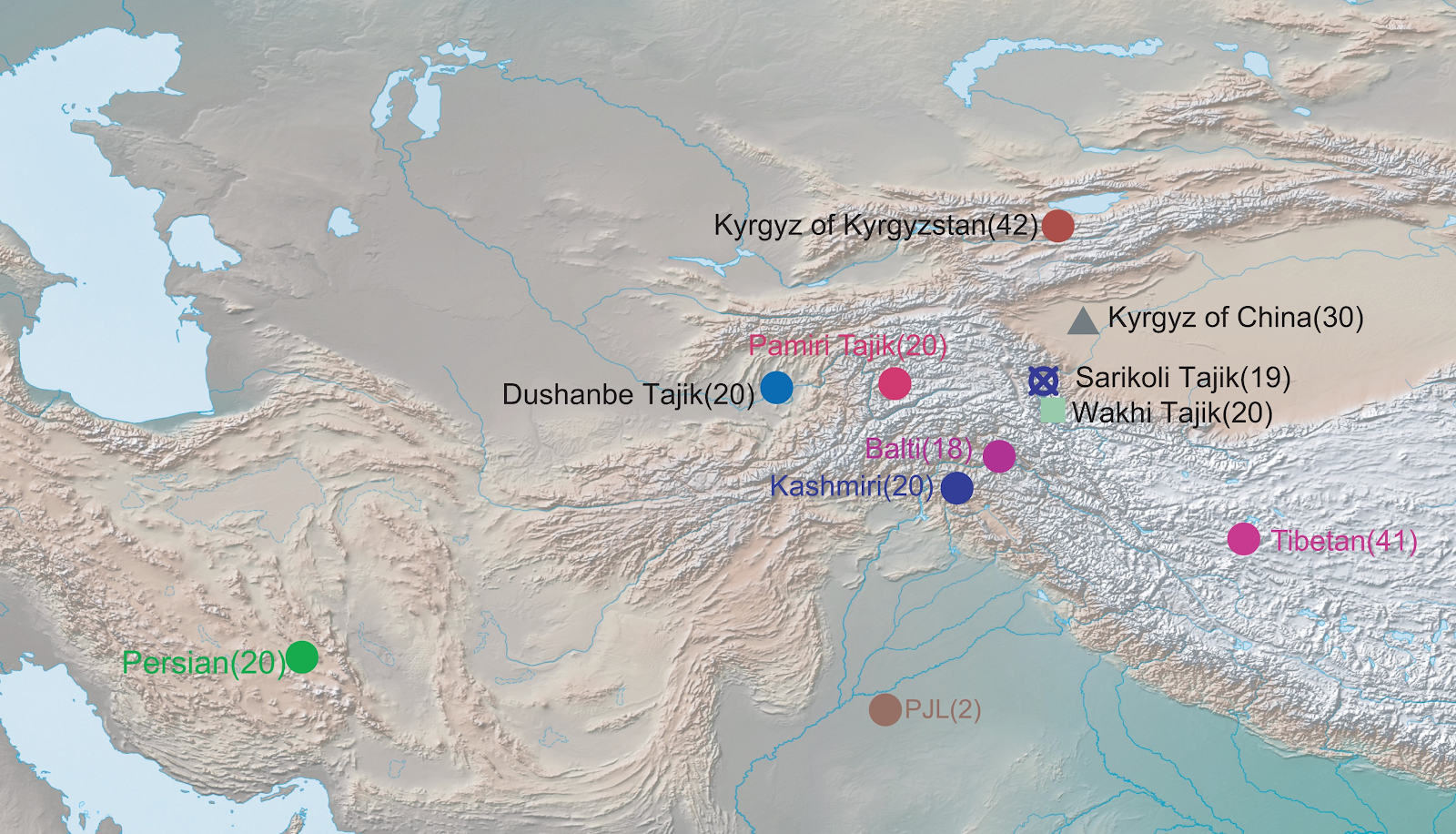Several Bronze Age Xinjiang individuals (e.g., Xinj_BA3, Xinj_BA4, Dzungaria_EBA1, and Dzungaria_EBA2) cluster closely with the four Tajik populations (fig. 2B), which may reflect a high genetic similarity between Tajik and Bronze Age Xinjiang populations. The Iron Age and Historical Era Central Asian and Steppe individuals are clearly separated from the four Tajik populations, except for the sporadic individuals from Xinjiang and South Asia (e.g., JEZK_IA3_oBMAC, LSH_IA2_oSte, Xinj_HE1, and Pakistan_RajaGira; fig. 2C and D).
Especially, compared with other modern Central Asian populations, the three Tajik from the Pamirs (i.e., Sarikoli Tajik, Wakhi Tajik, and Pamiri Tajik) share a higher level of genetic drift with Tarim_EMBA1 (supplementary fig. S13, Supplementary Material online). The Kyrgyz populations share great genetic drift with Neolithic, Bronze, and Iron Age populations from northern China and Mongolia (e.g., China_Wuzhuangguoliang_LN.EC, China_WLR_BA_o, China_AR_Xianbei_IA, and Mongolia_EIA_8), The Sarikoli Tajik and Pamiri Tajik can be modeled as a mixture of Russia_Andronovo, BMAC, Tarim_EMBA1, and Mongolia_Xiongnu_o1 (supplementary table S5, Supplementary Material online and fig. 4A). The results are supported by the qpWave (Reich et al. 2012) analysis that at least three separate sources are present in the Tajik populations (supplementary table S6, Supplementary Material online). The Tarim_EMBA1 is required under the four-way models in the admixture inference for the Sarikoli Tajik and Pamiri Tajik. When removing the Tarim_EMBA1, the admixture modeling failed. For the Sarikoli Tajik and Pamiri Tajik, the admixture models unanimously failed when using any group of Russia_MLBA_Sintashta, Central_Steppe_MLBA, Russia_Afanasievo, and Russia_Samara_EBA_Yamnaya as a Steppe source. For three highland Tajik (i.e., Sarikoli Tajik, Wakhi Tajik, and Pamiri Tajik), when we replaced Russia_Andronovo or Russia_Andronovo and BMAC with Turkmenistan_IA, the models worked well (supplementary table S5, Supplementary Material online), as Turkmenistan_IA was an admixture of BMAC and Andronovo (Guarino-Vignon et al. 2022). The Dushanbe Tajik can be modeled as a mixture of Turkmenistan_IA and Mongolia_Xiongnu_o1.
The major ancestry of Kyrgyz and Kazakh populations is from Xinj_HE3 (44.8–58.9%) and Mongolia_Xiongnu_o1 (41.1–55.2%; supplementary table S5, Supplementary Material online and fig. 4A). The Uyghur, Uzbek, and Turkmen populations are modeled as a mixture of Turkmenistan_IA (48.8–65.1%) and Mongolia_Xiongnu_o1 (34.9–51.2%). The most prevalent paternal lineage in the Kyrgyz (26/44) and Tajik (16/33) populations was haplogroup R1a1 (supplementary table S8, Supplementary Material online), which has been reported in Steppe-related populations, such as Corded Ware, Andronovo, and Sintashta. The mtDNA haplogroup C4 characterized in Tarim_EMBA1 (Zhang et al. 2021) is also found in the Kyrgyz and Tajik.
Ok, so Tajiks and the Kyrgyz are both ~50% R1a-Z93, and mtDNA related to the Tarim mummies is found in both.
Among modern Central Asian populations, the Tarim_EMBA1 was only detectable in the Sarikoli Tajik, Wakhi Tajik, and Pamiri Tajik from the Pamirs neighboring Tarim Basin (fig. 1). In the Dushanbe Tajik west of the Pamirs, as well as other Turkic-speaking populations, we failed to detect the signature of Tarim_EMBA1 ancestry. It is expected that western Tajiks in Uzbekistan from the previous study (Guarino-Vignon et al. 2022) may have no Tarim_EMBA1 ancestry.
So, only Pamiri Tajiks (includes Sarikoli, Wakhi as the mountain range is the Pamirs) have detectable Tarim EMBA type ancestry. This rules out any such ancestry in non-Pamiris, and certainly in Afghani Tajiks. I wonder if this ancestry was partially responsible for inflating the Steppe Andronovo of Pamiri Tajiks.






No comments:
Post a Comment